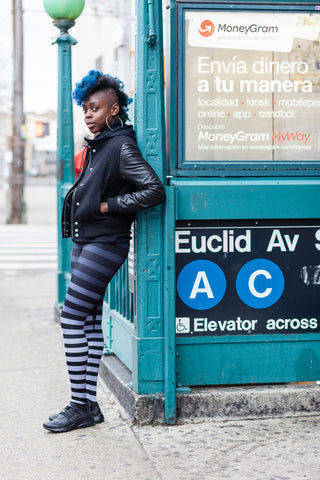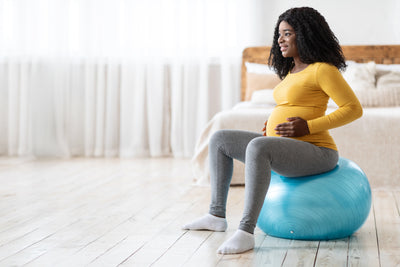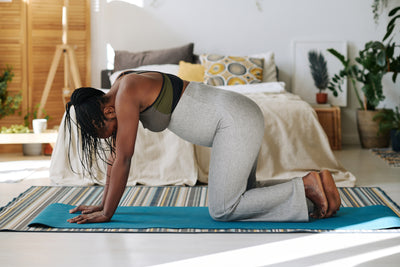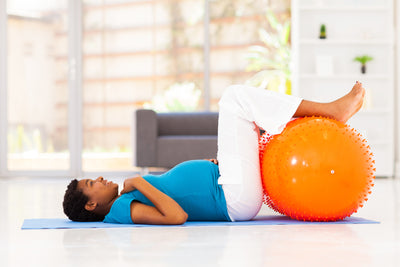This is the extended version of Ife's Women's Health article The Current Definition Of A ‘Fit’ Body Doesn't Include Most Black Women—Here’s How I’m Changing That
All my girls know this about me: After a long day of work, all I want to do is eat, put up my feet and watch reality TV. This Thursday night was no different as I plopped down on the couch with a juicy grass-fed burger and switched on my preferred not-guilty pleasure: The Real Housewives of New York.
Now I usually don't pay attention to commercials, except the occasional fitness ones. I'm a wellness professional who works in marketing and so I'm always curious about who these ads are targeting, how, and why. Many of the major fitness brands like ClassPass, MindBody, and Peloton pay for air time during Housewives' episodes, so it's no secret that they are chasing a largely female and wellness-oriented audience. Bravo TV’s Primetime line-up leads cable amongst women ages 25-54, and I'll be the first to raise my hand in all these categories. But as cool as I am with that, there was one ad that made me want to toss my bottle of kombucha at the screen.
It was an infomercial-style ad for a barre fitness brand. Its founder was the typical image of wellness we see marketed in media: blond, thin, short to average height and white. First, she talked about her brand and partnership with a popular streaming fitness app. Then you see the typical before and after photos, and in describing the benefits of her workout, the founder explains it gives women a “lean, not bulky, feminine body.”
So where does that leave those who don’t fit the “lean” body criteria? What does that make us? Me?
Many women in this world do not fit her ideals. Black women, in particular, are often excluded from what a “feminine” and “healthy” body means and we beat ourselves up trying to fit ourselves within this narrow definition.
When I was a teenager, I struggled with my weight. Not an uncommon story in largely Black communities. Growing up in East New York, Brooklyn, a lower income area, we didn’t have the access to quality produce that others had. The price-friendly things to get were at the bodegas around the corner from my home. A few more steps away was Tony’s Pizza Shop, or the Mcdonald’s. And if all that failed, our Cityline Chinese food spot delivered.

In the neighborhood, going out for a jog wasn’t an option. East New York at the time had the highest violence and murder rate in the city. This wasn’t an area for outdoor recreation. This coupled with poor food resources was the perfect formula for the Black overweight teen that I became — a teen who pop fitness culture would have never deemed as beautiful.
So I chased the lean dream. In my 20s, there were many days where I’d eat as little as I could while working out until I passed out. When boutique fitness started to become more popular, I turned toward barre. The image of the “lean dancer's body” shined like a gold medal in front of me. I jumped on it and fell in love with the group fitness experience and striving for the look I thought I wanted. I fell in love with barre so much that when they offered me a chance to teach, I jumped on it. I was so excited to finally be seen as someone that mirrored the barre ideal.
But then I started to see the other side of the industry.
I soon realized I was the only instructor of color for the brand in all of New York City. Terms like “leaning out muscles” and “dancer's body” had to be part of our vocabulary. One instructor even once said that a particular barre move gave you a lifted and cute rear-end, not a bulbous one. I had to hide the fact that I started lifting kettlebells and enjoyed it. “Bulking up” was considered an offense. Being born and raised in Brooklyn, my “accent” was being critiqued or made to seem foreign as opposed to the instructor with the Alabama twang. I was also restricted to a playlist of music that I wouldn’t necessarily play on mine or my friends' sound systems.
If I, as a paid employee of a community, had to hide who I was, I could imagine how clients who fell outside the norm felt. So before I had to talk one more time about “creating a dancer’s body”, I pirouetted out the door.
And yet, to think I’d left that world completely behind was a mistake. This culture is very much alive on fitness magazine covers, ads, commercials, packaging.
Look at the heads of today's biggest wellness brands. Most of them are lean white women. These brands are dictating what wellness for women should be and what “feminine” should look like along with selling products and services that will help you get to be like them. This leaves many BIPOC women feeling disembodied; it creates a sense of insecurity that many companies profit from.
Wellness brands don’t create content with us in mind, besides their occasional diversity post. Black women are leaders of classrooms, studios, and experts in wellness. Yet, we are underrepresented in the media and discounted largely due to the stereotype that links Black women to being masculine and unappealing.
In a piece for the New York Times, poet and author, Claudia Rankine, described how Serena Williams, arguably the world’s greatest tennis player of all time, has to constantly deal with body critiques and “racist notions that black women are hypermasculine and unattractive.”
“As long as the white imagination markets itself by equating whiteness and blondness with aspirational living, stereotypes will remain fixed in place,” writes Rankine. “Even though Serena is the best, even though she wins more Slams than anyone else, she is only superficially allowed to embody that in our culture, at least the marketable one.”
I remember watching the 2016 US Open in my mostly white, male office. My colleagues and I were discussing her playing style and technique, focusing on her talent as an athlete — or so I thought.
“She looks like a man!” one of the guys blurted and it took everything in my body from doing something that we’d both regret.
As the only black woman in the room I felt like I had to not only argue on Serena’s behalf defending the beauty in all her curves and muscles, I felt like I had to defend my own and every other Black woman whose body has endured inappropriate scrutiny.
Michelle Obama is a lawyer and holds degrees from both Princeton & Harvard. She held many prominent roles including Executive Director of a non-profit & University of Chicago Hospitals amongst others way before she had the title of First Lady. Despite all of that, her athletic body was torn apart by the same racist critiques that Serena faces today.
As she traveled the country campaigning for her husband’s election, she was called an “angry black woman”. And notable people have tried to use their transphobia as a way to further challenge her femininity. Joan Rivers joked that Michelle was transgender. Alex Jones claimed he has proof that she is as though being transgender is a scandal.
The list of prominent Black women who are ridiculed for their appearance amongst other things can go on, but the list for the women we don’t know can go even further.
This is why I created The Fit In: to make sure all women — particularly BIPOC women — know they are worthy as they are. I fell in love with boutique fitness because of the consistency it created for me and I wanted nothing more than to provide that benefit for others like me. The focus would be on the well-being of all bodies. And most of all, this space was going to be about community and connection.

The Fit In centers Black women as the experts in the room. This way anyone who enters knows that there are great Black female leaders in the wellness industry and that we come in all shapes and sizes. We set an example of what other versions of “feminine” can be and the spectrum is broad. Not lean.
Each instructor knows we are not just leading the room in fitness, but also in community. Our team represents the community it serves. It’s this dynamic collective of largely BIPOC women who come in a variety of shapes but still present an image of wellness. We understand that there is a different relationship to wellness in neighborhoods that were never provided wellness options. We understand that the fitness experience can be uncomfortable and triggering for many, whether it brings up shame, guilt, or other feelings of unworthiness. We lead with compassion, not competition. This allows us to build relationships with clients and stimulate them to foster relationships amongst themselves.
As many of our instructors also teach elsewhere, The Fit In is the only time many of them get to work with curvier bodies and women of color. And for them it’s not just the joy of leading others that look more like them, but it’s also the appreciation, love, and respect that The Fit In community gives them in return.
For many of our clients, signing up for a class at The Fit In was the first time they’ve felt committed to their health in a long time, if ever. Many came in chasing the same goal I chased when I got started in my journey. It’s what many of us have been groomed to do. But as they took a class with us and realized how much better their back felt after leaving that pilates class; how much fun they had in that “Bad Boys” themed barre class; how many of their neighbors love-hated jumping lunges as much as they did … many of them realized how much fun fitness could be without the pressures to be anyone but themselves. Those are the things that kept them committed to their health, not chasing a body type.
And that commitment to authenticity, along with collective support, is one of the most beautiful things I get to witness as a gym owner, coach, and friend-in-fitness. I believe these qualities are how BIPOC women — and women at large — heal each other and create our own empowered sense of wellness.






Leave a comment